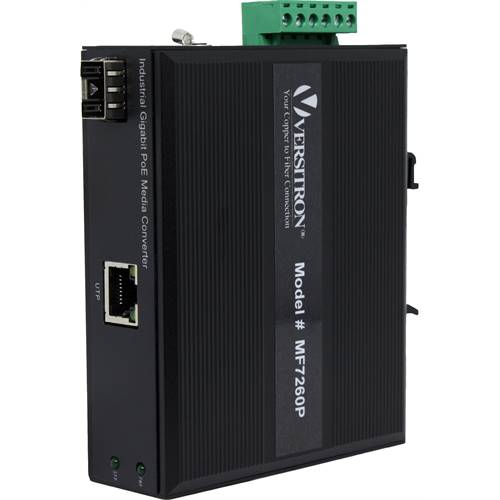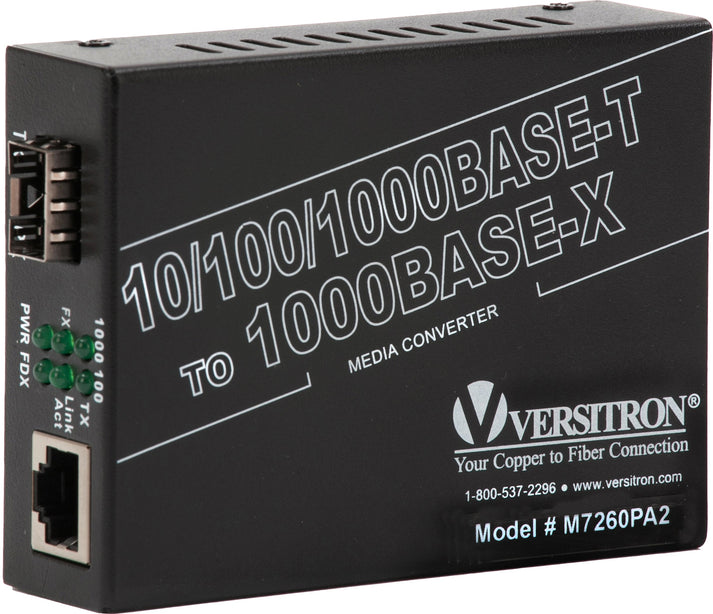
Introduction to Fiber Optic Media Converters
As the demand for high-speed, long-distance, and secure data transmission continues to rise across military, government, industrial, and commercial sectors, fiber optic media converters have become a crucial solution for bridging copper-based Ethernet networks with fiber optics. These devices allow seamless conversion between different transmission media, such as 10/100/1000Base-T to 1000Base-SX/LX media converters, enabling scalable and reliable infrastructure for mission-critical applications.
Why Fiber Conversion Matters in Modern Network Architecture
From industrial control network converters to government building fiber converters, fiber optic technology provides unmatched bandwidth, immunity to electromagnetic interference, and extended reach. Many organizations rely on Gigabit media converters with SFP GBIC technology to future-proof their networks while ensuring compatibility across existing and legacy systems.
Media converters also support both single-mode fiber converters and multimode fiber Ethernet converters, enabling flexibility depending on the environment—whether it's a long-distance fiber media converter used in smart grid infrastructure or a multimode to singlemode fiber converter deployed at a manufacturing plant.
Check Our Fiber Optic Media Converters Collection
Versatility Across Environments: Industrial, Government, and Military Use Cases
In harsh industrial settings, where high EMI resistance and temperature tolerance are non-negotiable, organizations opt for industrial media converters for harsh environments. These often include features like DIN rail mountable media converters, redundant power media converters, and wide temperature range media converters, ensuring continuous operation in factories, warehouses, or oil and gas installations.
On the government side, a secure government fiber media converter is essential for public surveillance networks, smart city integration, and municipal infrastructure. Applications such as fiber converters for public safety networks, public sector media converters, and smart city fiber optic converters are now standard in public sector procurement.
Military environments have their own specialized needs, often requiring ruggedized media converters for military use, MIL-STD media converters, and field deployable media converters. These include products like a tactical fiber media converter, military Ethernet to fiber converter, and even battlefield IP video converters to facilitate real-time surveillance and secure communications in the most demanding terrains.
Media Converters in Surveillance and IP Security Networks
Modern surveillance systems depend heavily on fiber optic CCTV converters to transmit high-resolution video data across vast distances. Whether installing a security camera PoE media converter for a building perimeter or integrating a PoE injector for IP cameras into an outdoor tower setup, these converters ensure reliable uptime and data integrity.
For IP camera networks, a network video recorder fiber converter provides seamless integration with existing infrastructure, while surveillance system fiber media converters support both point-to-point and star topologies. Cities deploying smart poles or towers utilize fiber converters for smart poles and surveillance tower media converters to enable intelligent monitoring and traffic control.
Exploring Specific Converter Types for Unique Applications
When choosing a media converter, the port type and feature set are critical. For legacy infrastructure or specific fiber types, you may need an SC fiber port media converter, ST fiber port media converter, or RJ45 to SC fiber media adapter. Depending on your application, products such as a SC duplex fiber converter, ST duplex fiber converter, or SC to ST fiber converter may be necessary.
For power-hungry applications, a PoE+ gigabit industrial media converter or fiber optic media converter with PoE delivers both data and power over fiber. Military and tactical deployments benefit from a PoE media converter for military applications, which are often paired with a secure fiber media converter for encrypted communications.
For installations in smart buildings and commercial structures, a commercial building fiber converter or smart building network converter supports IP systems, access control, and automation networks. Meanwhile, manufacturing plants and automation facilities deploy factory automation fiber converters, industrial PoE media converters, and industrial surveillance fiber converters to handle machine-to-machine communications securely and efficiently.
Managed vs. Unmanaged Media Converters
A managed fiber media converter offers network administrators visibility and control over traffic, link status, and performance, often supporting SNMP, VLAN tagging, and redundant paths. In mission-critical setups such as data centers or smart grids, Layer 2 managed fiber media converters help optimize network traffic and minimize downtime. These are also useful in enterprise network fiber converter setups requiring low-latency transmission and link redundancy.
Unmanaged models are plug-and-play and ideal for simpler deployments. Whether connecting endpoints in a LAN to WAN fiber media converter setup or expanding a campus network fiber converter, these converters are budget-friendly and reliable.
High-Speed and Long-Distance Solutions
As data demands grow, high-speed converters are essential. A 10 Gigabit media converter with SFP+ port enables fast transmission over long distances, while a SFP+ media converter with RJ45 facilitates copper-to-fiber upgrades in existing 10G Ethernet environments. Use cases include 10G Ethernet to fiber converters, copper to SFP+ converters, and non-blocking gigabit fiber switches.
For optical backbone needs in universities, military bases, or enterprise zones, organizations deploy fiber optic backbone converters, campus fiber optic expansion kits, and long haul data fiber converters. These devices are designed to be scalable and robust, with features such as automatic link fault detection converters and redundant fiber link converters.
Deployment in Critical Infrastructure and Utilities
Power and utility companies rely on hardened fiber solutions for SCADA and control systems. A fiber converter for utility networks, power substation fiber converter, or smart grid fiber optic converter plays a key role in maintaining service continuity. These systems often use multi-port fiber media converters to connect numerous devices while maintaining fiber isolation and speed.
In transportation and aviation sectors, fiber converters support high-speed, secure communication systems. Deployments include railway communication fiber converters, airport surveillance media converters, and transportation system fiber converters. Emergency services and law enforcement agencies use first responder fiber converters, police surveillance camera fiber units, and emergency response fiber adapters for real-time visual intelligence.
Advanced Capabilities: Security, Monitoring, and Redundancy
Security is a top concern, especially in government surveillance network converters and national defense fiber connectivity. Features like encryption, auto-negotiation, and flow control are built into high-end models. A secure VPN fiber media converter, secure zone network fiber bridge, or data encryption fiber media device provides additional protection against data breaches.
In environments requiring uninterrupted service, features such as dual power input media converters, uninterrupted power fiber converters, and media converters with surge protection protect against power loss or electrical anomalies. Meanwhile, passive cooling industrial converters, IP66-rated fiber media converters, and NEMA-rated industrial converters ensure environmental resilience.
Supporting Multi-location, Remote, and Maritime Operations
For distributed networks, multi-location fiber deployment solutions and remote site fiber media converters ensure consistent performance across wide geographies. Remote access is enabled by tools such as a remote access fiber converter, fiber converter for critical assets, or disaster recovery network fiber converter.
In naval and maritime communications, a fiber converter for naval communications or maritime network fiber converter facilitates secure communication onboard ships, submarines, and shore installations.
International and Regional Demand: APAC Market Growth
The global fiber converter market is growing, especially in the Asia-Pacific region. Rising infrastructure investments in the China fiber optic converter, Japan fiber media converter, and South Korea fiber converter markets have led to widespread adoption in smart cities and industrial zones.
Emerging economies like Malaysia fiber optic media converter, Thailand fiber converter, Indonesia fiber optic converter, and fiber converter for Indian market are also expanding their deployment of fiber technology, especially in the education, defense, and commercial sectors. Collectively, the Asia-Pacific fiber media converter market represents a significant growth opportunity.
Innovation Spotlight: VERSITRON’s Leadership in Fiber Media Converters
VERSITRON is a leading manufacturer known for reliable and ruggedized media converters. From a 10/100Base-TX to 100Base-FX converter to a SFP GBIC fiber converter, their product line covers a wide range of needs. Products such as the M7273SB multimode ST converter, SG71090A chassis-based converter, and M7280 10 Gigabit SFP+ converter are tailored for military, government, and commercial deployment.
They also offer 14-slot media converter chassis solutions for high-density deployments, as well as compact DIN rail fiber media converters for small-scale installations. Whether you're looking for a point-to-point fiber converter or a fiber switch with PoE+ and SFP, VERSITRON provides reliable options backed by decades of industry experience.
The Future of Networking with Fiber Media Converters
As smart cities grow, public safety initiatives expand, and automation continues to transform industries, fiber media converters will remain central to network transformation. The ability to bridge copper and fiber, provide power through PoE, and maintain uptime in extreme conditions makes devices like the SFP fiber media converter 1000Base-LX and auto-negotiation media converter indispensable.
Conclusion
The deployment of fiber optic media converters is no longer a luxury—it’s a necessity for any organization that values speed, security, scalability, and resilience. From a Gigabit Ethernet to fiber converter in a smart building to a tactical communication PoE converter on a battlefield, these devices offer reliable and flexible connectivity across all environments.
Whether you're upgrading to a 10/100/1000Base-T to fiber converter, installing a PoE+ injector with fiber conversion, or expanding a campus network fiber converter, choosing the right media converter can define the performance and reliability of your entire network.
By integrating products like a managed gigabit fiber converter, a redundant link PoE converter, or a secure fiber media converter, you're not only investing in your current infrastructure—you’re preparing for a future of high-speed, secure communication across every sector.









